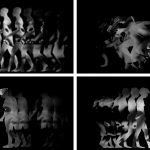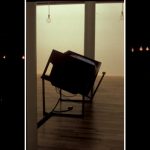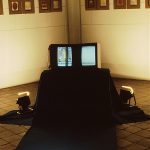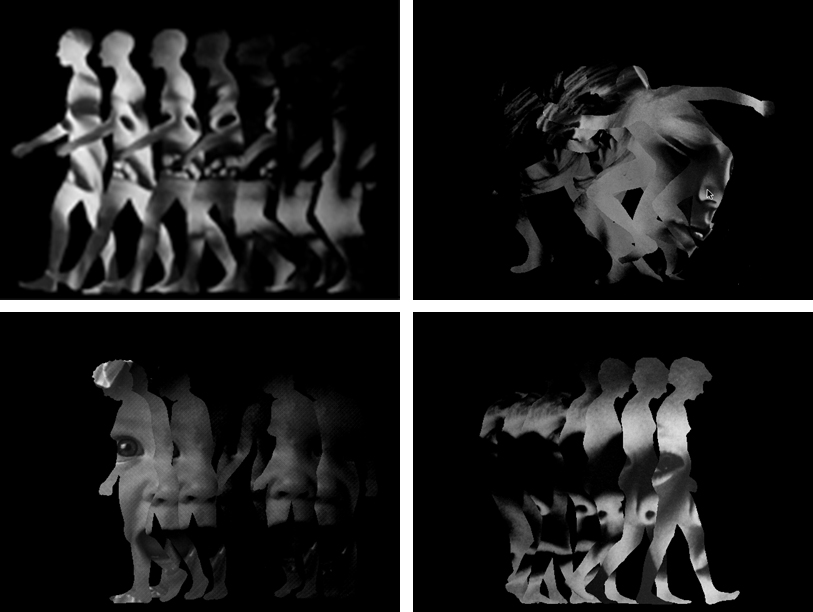Simon Biggs: Solitary
Title:
- Solitary
Artist(s) and People Involved:
- Simon Biggs
-
- National Institute for Computer Animation (SCAN)
Exhibiting Artist(s):
Symposium:
Venue(s):
Artist Statement:
The piece is based on the texts of the late Roman philosopher Boethius, and deals with the fluid and ultimately impossible nature of identity. The work makes use of sensory deprivation and stroboscopic visual effects to immerse the viewer in a disorienting environment. The work uses remote visual sensing techniques to track the viewer. If the viewers’ remain static then they see nothing, are left in total darkness, but as soon as they move large human shapes begin to follow them about the room. At first the shapes appear to be shadows, but then resolve into the faces of young children, observing the viewers actions.
Solitary deals with the fragmentary nature of memory through time, and the ensuing fragmentation of identity. What is the relationship between identity and time? How does this indefinable medium within which we are all suspended shape our being? What are the traces we leave on the temporal surface? How do these traces, these shadows of ourselves, function in constituting our memories of ourselves, and thus our sense of being? Does the relationship between time and memory imply that we are not one, but many selves? Who are these selves, and how do they exist? What is the relationship between our actions, our being, and our sense of time, space and memory?
One viewer at a time may enter a large, dark and silent space. It is entirely empty, but as they move about the space they leave behind them a trace of black and white shadow-like figures. These figures however, are not their own shadows but the shadows of others. Each shadow-figure is composed of a short animation (walking, turning, falling, etc), and over a short period of time each figure decays (fades) to black. Subsequently there are never more than eight shadow-figures present on the wall, each darker than the other, creating the effect of a fading and extremely slow stroboscopic image of other people inhabiting the space with the viewer. The period of time it takes for a figure to fade away, and the number of figures visible, is a function of the viewer’s movement. So long as the viewer remains in motion then they will leave an unfolding trace of figures, but as soon as they stop moving the figures soon fade to black, leaving the viewer alone in the dark and silent space. Thus the viewer defines or creates their sense of time through the nature of their action. Time and space are seen as functions of the self.
Within the contours of each shadow-figure there is another animation cycle composed of children’s faces (smiling, looking, turning, etc), which follow the shadow-figures animation. The images of child-hood, in black and white, help evoke in the viewer a sense of memory, whilst the otherness of both these faces (who are unknown) and the shadows follow the viewer, as if they were the viewer’s own shadow.
Solitary utilises live computer graphics, remote visual sensing techniques and digital projection to immerse the viewer in another sense of time and space. The computer is used not only to make this possible but as a metaphor for the suspension of the self in contemporary information media. This can in turn be seen as a metaphor for the functioning of our own memories and the manner in which we construct our identities in the non-linear and fragmented nature of time and space. At what point does the time/space constitution of the self in the world and in media technology merge or collide? Is there a separation here, or are these two states of being inexorably merging into one world?
Technical Information:
1 interactive video projection, black and white, silent 8 x 12 x 6 metres
Other Information:
An interactive digital video projection installation
Website:
Video:
Category:
All Works by the Artist(s) in This Archive:
- Simon Biggs
- More Art Events from Simon Biggs in this archive:

Solitary
[ TISEA]
The Temptation of Saint Anthony
[ SISEA]
Alchemy
[ SISEA]
Golem
[ FISEA]





